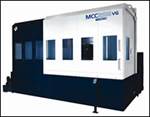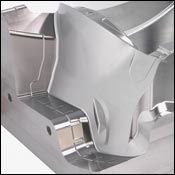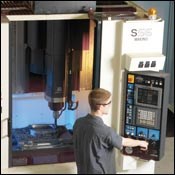A Supplier View on a Decade Of Moldmaking Progress
There has been a tremendous amount of change in the U.S. moldmaking industry over the past 10 years, and mold shops that adopt new machine tools, services and technology will enhance their capabilities for long-term success.
Throughout the last 10 years, the rate of change has increased and technology has led to new possibilities in mold design and production. The most significant industry changes have been in regard to production techniques, manufacturing speeds, mold size and mold complexity.
Large, complex molds and micro molds have replaced small, simple-cavity molds. Greater emphasis is being placed on production leadtimes speed, and agility. U.S. shops are turning to advanced machine tools and cutting edge manufacturing approaches to help reduce costs and meet the demanding just-in-time production schedules.
It comes as a shock to no one that the driving factor of change in the moldmaking industry has been the rise of off-shoring and its associated effect on pricing. U.S. moldmakers are increasingly feeling the pressure of foreign competition.
While U.S. moldmakers have lost a portion of less complex, lower technology, commodity work to overseas competitors, it’s not all gloom and doom. This void in commodity manufacturing has been filled with value-added products and services, which foreign markets struggle to provide. Moldmakers are finding success by taking advantage of unique or emerging industries such as medical, micro, large molds and high-value tooling.
Several niche markets have emerged. One of the most profitable is the medical market, which demands complexity, speed, and intricate mold designs on a daily basis.
As the industry changes, so too must machine tools and the associated manufacturing techniques. After all, what good is a hefty micromachining contract if you don’t have the appropriate tools to complete the job? “Faster” and “more complex” are terms that are thrown around a lot these days—in the same sentence as “tighter tolerances”, “finer surface finish”, “better blends and matches” and “less hand working.” Just as moldmakers change to meet the needs of their customers, suppliers have to change to meet the needs of their customers. That means innovative technology and even more innovative applications engineers.
Collapsed Leadtimes, Better Results
Ten years ago, it would not have been uncommon for the leadtime to manufacture a mold to be in the 12 to 16 week range—three to four months. However, over the past decade significant technological advancements in both machine tools technologies and manufacturing techniques have drastically reduced production times. Today, the leadtime to manufacture the same mold would be two to four weeks—often less than one month. Trial parts can be quickly molded using rapid prototype cavities created in a day or two. Now, time-to-market concerns often require production in weeks or even days, something that would have been thought unrealistic only a few years ago.
In addition to demanding faster cycle times and shorter leadtimes, customers expect tighter tolerances and higher quality surface finishes. Typically, doing a job faster produces a lower-quality product. Unfortunately, in this industry, quality defines who a moldmaker is. If quality suffers, business suffers.
Machine Tool Technology
As a result, moldmakers are turning to the machine tool builder for products that deliver higher productivity, greater precision, better surface finishes, and eliminate additional time-consuming hand finishing work. To meet this need, machine tool builders have dramatically increased machine axis velocities and accelerations, greatly expanded spindle rpm, while tightening positioning accuracy, repeatability and geometric tolerances. Control enhancements also have facilitated high-speed machining of complex, three-dimensional mold shapes to tighter tolerances.
A decade ago, 10,000 rpm was considered a fast spindle and 10 ipm federates were acceptable. Today, machines routinely incorporate 20,000, 30,000 and even 40,000 rpm spindles, and feedrates of 200, 300 and 400 ipm are commonplace. Combining these advanced machine tools with new manufacturing techniques—such as high-speed milling routines and tooling, hard-milling to eliminate multiple steps of machining, and high performance machining utilizing programming tricks and machine capabilities have provide the moldmaker with the necessary tools to compete and win.
In the past, it was virtually impossible to get a finished mold directly from a machine tool. A moldmaker would first machine the mold in the steel’s soft state, cutting a mold cavity that was fairly rough. After heat treating, the mold would be finished machined to as close to the final tolerances as possible. Ten years ago, the typical tolerance that might be achieved was +/- 0.002 inches. After hours of cleaning up the core and cavity by hand, the mold components would be ready for initial assembly. The two mold halves would be fit together and additional hand working would be required to actually create the proper fit and clearances between the working parts of the mold. Only after this labor intensive and time-consuming process was it actually ready for a test shot. Once again, after the initial parts were molded—typically, there would be additional hand-polishing required to meet part finish requirements and some additional fitting work to insure proper match-lines, seams and no flash on the finished part. Not to mention the fact that the mold would often have to be machined twice—once for the initial geometries and a second time after heat-treating to harden the mold.
Machining in the Hardened State
Perhaps the biggest step forward to reduce the time of recent years is the ability to cut the mold in the hardened state, often eliminating the two rounds of machining required and the wait-time for heat treating. A decade ago, it was understood that hardened steels were typically to be finish machined, and more often than not, hand finished. Today’s machines1 are capable of machining materials in the 60+ Rockwell range, and have even successfully machined carbide at 80+ HRc.
Given this ability, machining in the hardened state is not only possible, but preferable, because it frequently eliminates the time consuming EDM process. However, there is still a place for EDM. This is especially true for difficult-to-machine areas, such as deep ribs, tough radii, and very tight-tolerance features.
Burning on a Ram EDM is very accurate, but it also is very slow, particularly on a complex or large mold. Having the ability to mill in the hardened state without the use of Ram EDM saves overall mold production time and aids in the timely delivery of the mold, thanks to the simplified process and cutting directly to zero on the milling machine. A hardened block goes into one machine and a finished mold comes out.
By using advanced machine tools, moldmakers can eliminate additional, labor intensive, time-consuming, expensive steps and cut mold components to zero with accuracies to +/- 0.0005 inches or less in materials of 60 HRc and harder. Using machine tools that allow them to reach these tolerances and mill in the hardened state eliminates additional hand finishing and fitting, provides outstanding surface finishes, helps shops shorten leadtimes and reduce costs dramatically, giving them a definite advantage relative to overseas competition.
Many customers report that the primary reason they’re still successful, even after losing simple work to lower-cost providers, is due to their ability to turn out high quality molds quickly. They credit their teams of innovative engineers, new processing techniques and tooling, along with the ever-advancing machine tool, which allows them to produce molds faster and without the need for re-work, as is all-too common when work is sent overseas.
Areas of Growth Potential
Re-Working Overseas Molds
Perhaps one of the more interesting markets we’ve seen in moldmaking in recent years is applying North American quality to overseas molds. In other words, shops are finding that making poorly made molds work properly, even having to re-machine features or whole molds, is an area of growth potential.
Even the simplest molds have to fit together properly and the resulting parts must meet specific finish and tolerance requirements. When a mold is produced thousands of miles away from where it’s used, the mistakes of the molder often can’t be corrected efficiently without bringing in a local craftsman with high-performance machining abilities.
Often, these orphaned and defective molds have already been heat treated, so those willing to take on this work have to fix the mistakes in hardened steel. They need hardmilling skills and a machine capable of cutting hardened tool steel, as mentioned earlier.
Re-working defective overseas molds is a new and growing sector of moldmaking with great potential for those willing to fix the mistakes of others and invest in machinery capable of high-accuracy hardmilling.
Demand for Micro
Advanced manufacturing technologies have made micro components and devices commercially viable for the aerospace, automotive, electronics and biomedical industries. Mass replication of these devices requires micro molding, forming and stamping technology on an economical scale.
Micromachining certainly has its share of challenges. Cutting forces and tool pressures on cutting tools as small as 0.05 mm in diameter are significantly different than those on larger applications. Machine tools designed for micro must be able to recognize and achieve submicron movement commands. Machine tool stiffness and rigidity also are extremely important here, as even the slightest distortion or deflection will destroy the dimensional integrity of such miniature parts. Unchecked temperature change can quickly overshadow micro component tolerances. In addition, do not underestimate the challenges of measuring parts and part features in the micron range.
Some shops are producing flat parts in materials such as 420 stainless steel that require tolerances of 0.0002 inches, with absolutely no variance, over as much as a 6-inch distance.
Micromachining requires tremendous technology advances in tool construction and design, and usually calls for careful programming and very small tools that are hard to handle. But with the demand for miniaturization at an all-time high, those shops that have adopted the proper technology are quickly realizing the benefits.
Large Mold Manufacturing Requires Specialized Tools
Big molds require a substantial investment, which includes massive tooling that’s hard to move, heavy-duty machinery and other equipment to make the process as efficient as possible.
Modern high-performance machining is widely accepted to be a cost-effective solution for the production of small mold cavities with complex geometric surfaces. But the same demand for detail is often overlooked in selecting machinery for the production of larger molds. When dealing with large mold production more is invested in material costs and time, which increases the risk associated with scrap and re-work, placing greater emphasis on the quality of machinery used to manufacture these large tools.
It’s a significant challenge for moldmakers to get these operations set up to the point where they can be run efficiently. As a result, large moldmakers are using high-end CAD/CAM systems that are capable of generating effective toolpaths. This technology, coupled with machine tools that can remove materials at faster rates unattended will greatly help large moldmakers reduce production times.
Molds Are Growing in Complexity
In addition to size, mold complexity is becoming a significant issue in the moldmaking industry. Today, more emphasis is being put on ultra-precision, multi-cavity injection molds, specifically for customers in the medical, packaging and technology markets.
Some complex molds can have more than 1,500 parts and require extreme levels of accuracy and precision. As U.S. moldmakers take on more complex work, they are spending more time planning their molds and turning to reliable machine tools with excellent cut times and accuracy that eliminates the need for hand-work so they can turn out more molds more quickly.
Surface finish requirements can become a major issue, as some complex molds don’t allow hand-polishing in areas where a human hand can’t fit. The machine has the job of finishing the part, and has to perform this task flawlessly to allow the mold to work properly.
Moldmakers are relying more on advanced machines2 with fast control capabilities to speed up production on complex molds. They are looking to integrate total performance packages to process long, complex mold programs, at extremely fast speeds, while achieving levels of accuracy and finish previously unattainable.
Diversification
A new, emerging trend is for mold shop owners to take a hard look at their core competencies in order to discover where those abilities can be applied in other markets. While not giving up on moldmaking, these innovative shops are applying their machining and manufacturing expertise to satisfy the demands of aerospace, medical, energy and telecommunications customers.
These shops are finding that excess capacity can be quickly put to work in highly profitable production areas, as well as traditional moldmaking, allowing them to bid on a whole variety of new work.
This strategy of diversification can be an effective means of increasing business by utilizing the skills and equipment already in place to satisfy new customers.
After all, the production business currently booming in North America is that of the highest precision in tough materials, which is exactly the type of work moldmakers are used to. Not limiting your shop to molds can go a long way to a better the bottom line.
Change Is a Constant
There has been a tremendous amount of change in the U.S. moldmaking industry over the last 10 years. While theses changes can be attributed to increased competition from foreign markets and a myriad of technological advances, the results are easily seen in process improvements, increased quality and capabilities, and faster production speeds, which allow U.S. moldmakers to compete like never before.
More and more U.S. moldmakers will continue to adopt new machine tools, services and technology that help them to enhance their capabilities by manufacturing complex, large and micro molds. In doing so, they further differentiate themselves from competitors, both foreign and domestic, and that has always been the name of the game.
References
1 Makino’s V-series.
2 Makino’s Pro5 with Super Geometric Intelligence.
Related Content
How to Improve Your Current Efficiency Rate
An alternative approach to taking on more EDM-intensive work when technology and personnel investment is not an option.
Read MoreThe Critical Role of Management Representatives in ISO 9001
In ISO 9001 quality management systems, the Management Representative (MR) plays a crucial role. While the 2015 version of ISO 9001 no longer mandates this position, having a trusted management member serve as an MR remains vital for streamlining operations and maintaining quality standards.
Read MoreMaking Quick and Easy Kaizen Work for Your Shop
Within each person is unlimited creative potential to improve shop operations.
Read MoreTop 10 Topics to Cover During an ISO 9001 Manufacturing Audit
Take a look at this practical hands-on approach to conducting a quality audit.
Read MoreRead Next
Solutions for Your Large Mold Machining Challenges
The technology exists to successfully tackle large molds, as long as you acknowledge the problems associated with large mold machining and the machine design features that offer solutions.
Read MoreHow to Use Strategic Planning Tools, Data to Manage the Human Side of Business
Q&A with Marion Wells, MMT EAB member and founder of Human Asset Management.
Read MoreHow to Use Continuing Education to Remain Competitive in Moldmaking
Continued training helps moldmakers make tooling decisions and properly use the latest cutting tool to efficiently machine high-quality molds.
Read More
























